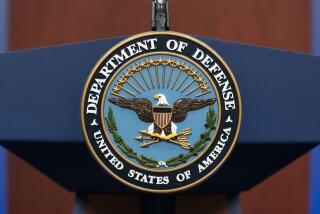With buildup, offensive begins
- Share via
WASHINGTON — The Army general in charge of day-to-day operations in Iraq said Friday that with all combat troops deployed in the Bush administration’s buildup now in place, the U.S. military would push more forcefully to root out insurgents in and around Baghdad.
Lt. Gen. Raymond T. Odierno said the new offensive differed from previous operations in the capital. He said the additional troops would allow U.S. and Iraqi forces to occupy neighborhoods once they are cleared of insurgents and to protect civilians as the areas are rebuilt.
“With the amount of forces that we have now, we will be able to stay in these areas ... where we’ve had either no or very little capability to do this previously,” he said from Iraq in a video conference with reporters at the Pentagon.
Parts of the offensive have been discussed by military officials as it got underway this week.
But by formally unveiling the overall strategy Friday, Odierno differentiated it from military actions taken over the last four months. For the first time, he said, all forces in the troop buildup were taking part in a coordinated offensive throughout Iraq’s midsection.
“We are beyond a surge of forces, and we are now into a surge of operations,” Odierno said.
Meanwhile, the military said Friday that a U.S. soldier was killed Thursday in fighting in southwest Baghdad, bringing to 3,546 the number of American troops killed in Iraq since the war began in March 2003, according to icasualties.org, a website that tracks military deaths.
The offensive, which is to run through the summer, includes the move of 10,000 U.S. troops into the province of Diyala and its capital, Baqubah, northeast of Baghdad. Violence has risen in Diyala as insurgents have poured in, fleeing the U.S. military in Baghdad and Al Anbar province in the west.
Odierno said the operation involves all 20 brigades deployed in Iraq, including five brigades -- about 17,500 troops -- in Baghdad and at least that many ringing the capital.
Since President Bush announced his new security plan in January, U.S. defense officials have insisted that any attempt to evaluate the buildup’s effectiveness was premature, because the five additional combat brigades ordered to Iraq would take months to arrive.
But as the troops arrived and the offensive began, Pentagon officials continued to debate how long the increased force levels would be needed.
Defense Secretary Robert M. Gates has expressed hope that a planned September evaluation of the plan will show sufficient progress to allow troops to begin returning home before the end of the year.
Odierno is known to think differently.
On Friday, he again suggested that extension of the buildup might be needed until spring. He said that key to the operation’s success would be the ability of Iraqi forces to take over the task of securing and rebuilding Baghdad neighborhoods, and that he did not believe they would be fully capable of those duties for several months.
“I think if everything goes the way it’s going now, there’s a potential that by the spring we would be able to reduce forces, and Iraqi security forces could take over,” Odierno said, adding that only after such transitions would a decision be made on reducing U.S. troop levels.
He suggested that though the rebuilding of some Baghdad neighborhoods was underway, attempts to secure and normalize areas under assault -- such as Baqubah -- were not likely to begin until August.
Odierno said the offensive already had produced some successes, citing 33 homicides in Baghdad this week, compared with 93 during the second week of January. Other military officials have said that after a brief uptick in civilian deaths there in May, the levels have dropped again this month.
The number of killings in the capital may have been reduced by the four-day curfew imposed after the June 13 bombing of the Golden Mosque, a major Shiite Muslim shrine in Samarra.
On June 18, when the curfew was lifted, the day’s death toll went up to 33, according to data provided by police. The military has said its numbers are lower than those of the police force, but it declined to say what they were.
--
tina.susman@latimes.com
Spiegel reported from Washington and Susman from Baghdad.
More to Read
Sign up for Essential California
The most important California stories and recommendations in your inbox every morning.
You may occasionally receive promotional content from the Los Angeles Times.














